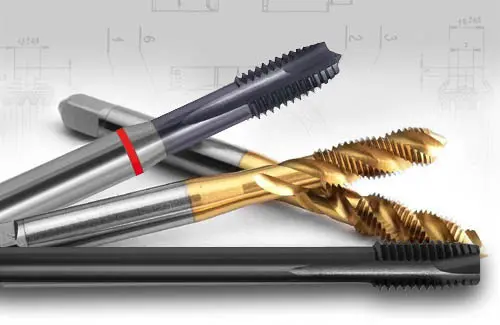The regular price is the current manufacturer's recommended price! FREE shipping for orders over EUR 41,67 within CZ+SK (PPLparcel)

Machine tool operators encounter various materials during machining, often very special ones. Individual materials differ in composition, hardness and abrasive properties. These different material properties place different demands on tools used not only in drilling but also in threading. Tap coatings are used to improve their performance, increase wear resistance and reduce friction when cutting threads.
The main benefit of PVD (Physical Vapor Deposition) coatings is to increase the service life and productivity of milling cutters during chip machining. The coatings are characterized by:
- high surface hardness
- high resistance to abrasion
- reduced coefficient of friction
- reduced heat transfer to the tool
The most commonly used coatings for thread cutting tools:
TiN (titanium nitride) – Increases hardness, reduces friction and extends tool life. A universal coating suitable for a wide range of materials.
- In the PVD process, a coating with a thickness of 2-4 μm and a microhardness of 2300 HV is achieved at 500 °C. This coating has good sliding properties and effectively increases the resistance of the tool surface to abrasive and adhesive wear. This single-layer coating can be used up to 600 °C. The coating is golden yellow in color.
TiCN (titanium carbon nitride) – It has higher hardness and wear resistance than TiN, suitable for stainless steels and abrasive materials.
- In the PVD process, a coating with a thickness of 2-4 μm and a microhardness of 3000 HV is achieved at 500 °C. This coating is highly wear-resistant. The low coefficient of friction prevents the formation of cold welds. This multi-layer graded coating can be used up to 400 °C. The coating is blue-gray in color.
TiAlN (titanium aluminum nitride) – Better heat resistance than TiN, suitable for machining harder materials.
- In the PVD process, a coating with a thickness of 3-5 μm and a microhardness of 3300 HV is achieved at 500 °C. The optimized ratio of hardness and internal stress of the coating layer increases the stability of the cutting edges of the tools. Excellent thermal and chemical resistance together with excellent sliding properties allow for increased performance in highly loaded operations. The titanium aluminum nitride coating can be used up to 900 °C. The coating is purple-gray in color.
Black Oxide (black oxide) or oxidation – This is not a hard coating, but a chemical surface treatment that reduces friction and improves heat dissipation, suitable for less demanding applications.
- In a chemical-thermal process in a special device, a layer of iron oxide is created on the surface of heated tools under the action of dry steam and pressure. This oxide layer increases the wear resistance of the cutting edge, increases corrosion resistance, improves tool lubrication. The coating is dark gray in color.
In addition to the commonly used coatings, there are other special coatings for taps that are used according to the specific application and type of machined material:
AlCrN (aluminum chromium nitride) – Resistant to high temperatures, suitable for high-stress applications.
CrN (chromium nitride) – Excellent wear resistance, suitable for sticky materials such as aluminum and copper.
DLC (diamond-like carbon) – Extremely hard coating with low friction, ideal for non-ferrous metals and alloys.
ZrN (zirconium nitride) – Similar to TiN, but with higher oxidation resistance and less material adhesion. Well suited for machining non-ferrous metals and plastics.
AlTiN (aluminum titanium nitride) – Very high temperature resistant, suitable for dry machining and hard materials.
TiB₂ (titanium diboride) – Very hard, low friction coating, ideal for machining aluminum and its alloys, as it prevents chips from sticking to the tool.
WC/C (tungsten carbide/carbon) – Extremely slippery coating, ideal for low friction applications, such as plastics or soft metals.
MoST (molybdenum disulfide) – Special coating with a very low coefficient of friction, suitable for machining highly sticky materials such as copper and brass.
TiSiN (titanium silicon nitride) – Very high heat resistance and hardness, suitable for extremely demanding applications.
CVD diamond coating – Extremely hard coating, used for machining abrasive materials such as composites or graphite.
NACo (nanocomposite aluminum oxide coating) – A combination of TiAlN and Al₂O₃, provides excellent thermal stability and wear resistance.
Selecting the right coating depends on the workpiece material, cutting conditions, and tool life requirements.
Další články:
Jak nabrousit vrták
Jak vybrat správný ruční závitník?
Vrtání a závitování jedním nástrojem
Jak vybrat strojní závitník?